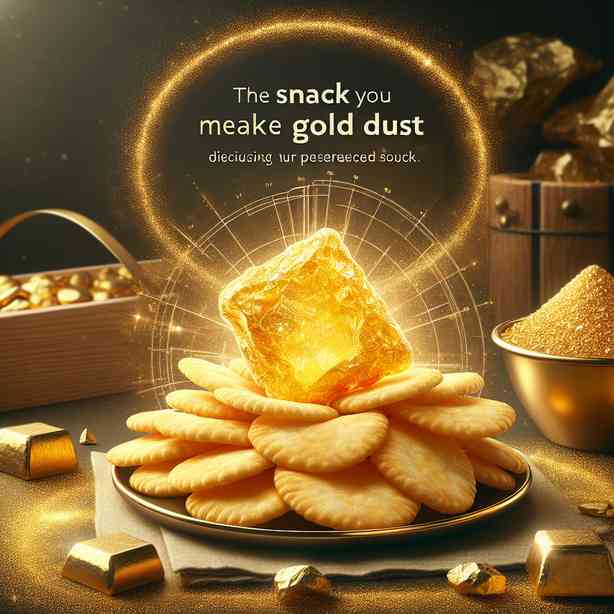
The Snack You Measure Like Gold Dust
In the realm of culinary delights, there exists an extraordinary category of snacks that tantalizes our taste buds yet remains elusive, much like gold dust. These snacks are not just meant to satiate our hunger; they embody culture, tradition, and an unparalleled craftsmanship that elevates every bite into a delightful experience. In this exploration, we will delve into the world of high-end snacks, uncovering what makes some of them so precious and sought after, akin to the most coveted treasures.
To start our journey, we first need to understand the underlying principles that define these sought-after snacks. The essence of a prized snack often lies in its ingredients. Premium quality components such as aged cheeses, organic nuts, or wild-caught seafood can transform a simple nibble into a luxurious treat. For instance, consider the process of making artisanal cheese. This meticulous endeavor involves not only selecting the finest milk but also aging it precisely to enhance its flavor profile. As a result, the cheese retains complex flavors that ordinary varieties simply cannot replicate. Thus, when indulging in such a snack, one is not just tasting food; rather, one is experiencing a rich tapestry of flavors that tell a story of dedication and craftsmanship.
Furthermore, the exclusivity of these snacks adds another layer to their allure. In a world that often emphasises mass production and accessibility, limited-edition releases or locally-sourced rarities stand out. Think of the distinction between mass-produced chocolate bars and unique, hand-crafted versions made with rare cacao beans from a single plantation. Such artisan chocolates may employ innovative flavor combinations such as lavender-infused dark chocolate or sea salt sprinkle, creating an unforgettable taste that lingers well after the last bite. Their scarcity and unique flavors allow them to be appreciated much like fine wine or craft beer, making them a luxurious choice for those who seek pleasure in uniqueness.
Of course, the presentation of these phenomenal snacks plays a crucial role in their desirability. The aesthetics surrounding a high-end snack can transform the eating experience into something truly captivating. Take, for example, the trend of gourmet charcuterie boards, often featuring an assortment of cured meats, artisanal cheeses, fresh fruits, and edible flowers. The careful arrangement and vibrant colors make it not just a meal but an artwork on a platter. This emphasis on visual appeal entwined with exquisite flavors creates a multi-sensory experience that elevates our perception of snacks from mere food to a culinary adventure.
Now let us turn our attention to cultural implications tied to these precious snacks. Throughout history, certain snacks have held a significant place in various cultures as symbols of celebration, hospitality, and even status. For instance, the intricate preparation of sushi elaborates a profound focus on not just the ingredients, but also on presentation and ritual. Enjoying sushi is considered a ceremony, where each piece reflects the respect for the sea and the skill of the chef. Thus, snacks and their preparation are intertwined deeply with cultural identity and heritage, illustrating a beautiful confluence of tradition and innovation.
On another note, the health-conscious wave has yielded new possibilities for delicious snacks that are equally nutritious. Snacks made from superfoods and natural ingredients can be just as luxurious and decadent without compromising health. Brands are emerging that exclusively use organic and gluten-free ingredients, offering delights such as kale chips, coconut macaroons, and energy bites crafted from nuts and dried fruits. These snacks challenge the conventional notion that indulgence is synonymous with unhealthiness, proving that one can savor rich flavors while considering their well-being.
Moreover, sustainability has become an essential topic within the realm of snacks. A growing number of snack producers are committed to environmentally friendly practices, sourcing their ingredients from farms that prioritize ecological balance. This commitment extends beyond just ethical sourcing; it includes minimal packaging, reducing carbon footprints, and utilizing renewable energy in production. Consumers increasingly value snacks that not only taste good but also resonate with their values, thus aligning their indulgences with their principles.
As we continue navigating through the extraordinary landscape of snacks, we can also note the role of technology and innovation. Modern methods of preservation and preparation mean that typically perishable items can now be transported and enjoyed far beyond their native locales. Techniques such as freeze-drying, for instance, allow fruits to retain their vibrant flavors and nutrients while enhancing their texture, making them appealing snacks that last much longer. This blending of science and culinary art has opened up endless possibilities for snack creation, enabling artisans to experiment in ways that were not previously conceivable.
In closing, the realm of high-end snacks represents a delightful convergence of art, science, and culture—much like the value of gold dust itself. These snacks serve as more than just a means to satisfy one’s cravings; they are an experience to cherish and celebrate. Through quality ingredients, artisan craftsmanship, cultural significance, aesthetic presentation, health consciousness, sustainability, and innovation in creation, these snacks merit their distinction and desirability. So, the next time you indulge in a snack that feels as precious and elusive as gold dust, remember that you are partaking in something truly special, where every bite tells a story rich in history, culture, and creativity.


